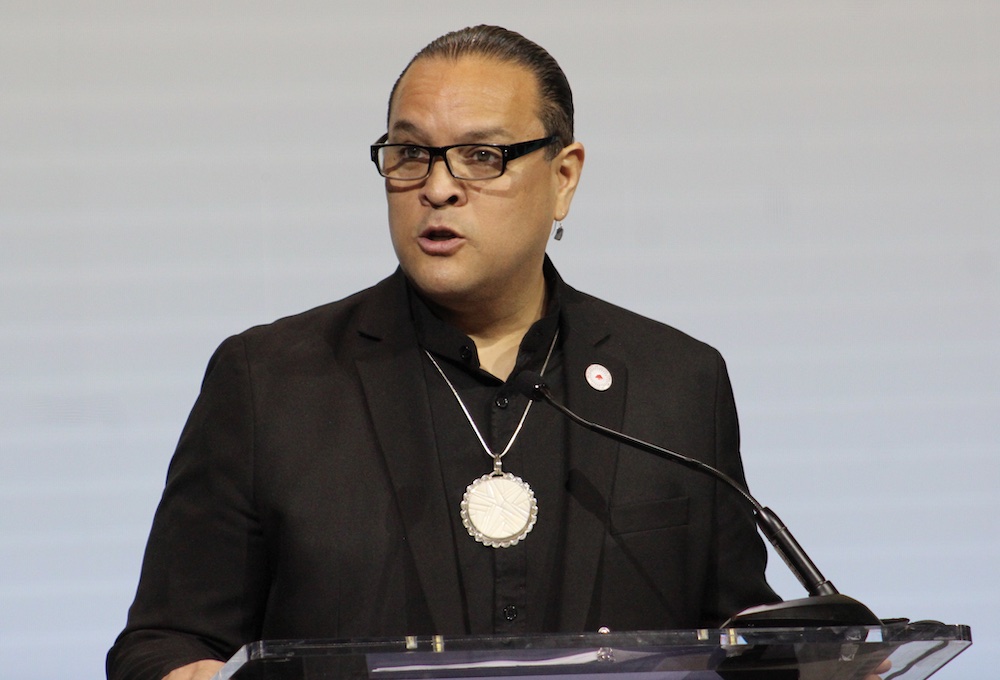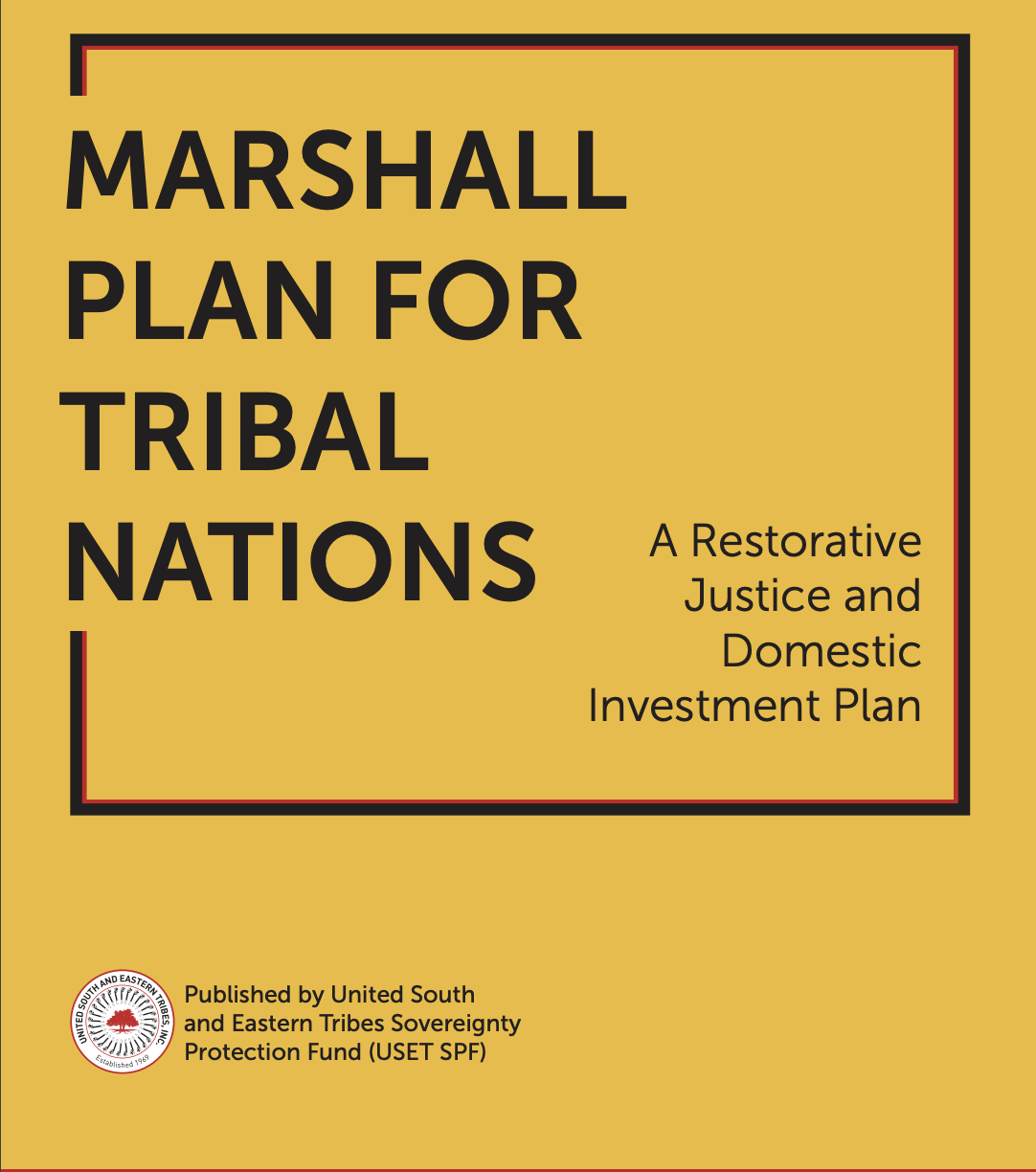
- Details
- By Levi Rickert
Opinion. Kitcki Carroll (Cheyenne and Arapaho Tribes of Oklahoma), executive director of the United South and Eastern Tribes (USET), compares the current condition of Indian Country to the devastated condition of Europe in the aftermath of World War II. Back then, the United States employed the European Recovery Program — most commonly known as the Marshall Plan — to invest in the rebuilding of Europe with a goal of achieving a stable economy and sustainable peace.
Carroll brought his message to the National Congress of Americans Indians (NCAI) at its 80th Convention and Marketplace in New Orleans last November. He presented the Marshall Plan for Tribal Nations: A Restorative Justice and Domestic Investment Plan to the NCAI attendees.
Carroll believes the federal government has failed to keep its promises made in treaties. The results have left many in Indian Country with the lack of infrastructure such as running water, electricity, and poor roads.
He cited the 2003 report released by the United States Commission on Civil Rights called A Quiet Crisis: Federal Funding and Unmet Needs in Indian Country that detailed the federal government’s failure to fulfill treaty obligations. In 2018, the Commission on Civil Rights reported that—due to a variety of reasons such as historical discriminatory policies, insufficient resources, and inefficient federal program delivery—American Indians and Alaska Natives continue to rank near the bottom of all Americans in terms of health, education, and employment.
Carroll says it’s time the United States dealt with Indian Country in the fashion it did in Europe with the Marshall Plan.
“The Marshall Plan for Tribal Nations is not a replacement of the annual appropriations process,” he said. “This is an infrastructure investment of significant size. The effort to secure full mandatory funding for any country appropriations exists in perpetuity, for as long as the United States holds the assets, the land and the natural resources associated, then they have that responsibility to fulfill that promise–in perpetuity. So there are two separate things even though they are related.”
To implement the Marshall Plan, the United States committed an enormous amount of money, which in historic dollars came with a $13.3 billion price tag. Back then, it represented 13 percent of the U.S. budget expenditures, about 1% to 2% of the U.S. Gross Domestic Product at the time.
The Marshall Plan proved to be mutually beneficial to both the United States and Europe. Over the course of just four years, European industrial production rose by 55%, with agricultural output increasing by nearly 37%. For the United States, its investment helped to maintain and grow its own economic stability with European trade. Additionally, the investment translated into the United States gaining more status in the eyes of the world. The Marshall Plan was viewed as highly successful.
While Carroll did not put a price tag on the Tribal Nations Marshall Plan, he thinks it’s time for the United States to make the same type of investment in Indian Country.
“Like the European Marshall Plan, the parameters of the Tribal Nations Marshall Plan must be determined in close consultation with, and subject to the consent of, the funding recipients: Tribal Nations,” the plan writes. “This process would be best served by establishing a Department of Tribal Nation Relations for consultation and coordination purposes. The Department would take the lead by establishing a Commission that includes Tribal Nations, the White House Council on Native American Affairs, the Office of Management and Budget, the Government Accountability Office, and others to make funding and allocation recommendations through a collaborative assessment of the United States’ unfunded trust and treaty obligations.
The Commission should present to Congress a reliable funding number and allocation plan. Rather than studying the problem—as so many reports have already done—the Commission should focus on actions to execute the Tribal Nations Marshall Plan.”
As the U.S. Commission on Civil Rights has expressed in two reports, the federal government has failed Indian Country. While the Biden administration has been favorable to Indian Country, more needs to be done.
“Every effort worth pursuing has always started with the courage and intent to take the initial first step. I want to express gratitude to all those who played a role in leading us to where we are today. I now humbly ask that we all commit to taking the first step into this next phase of our journey together, drawing upon our collective strength and wisdom as Indigenous people.” Carroll said in his remarks.
I'm inviting the White House and Congress to read the Marshall Plan for Tribal Nations: A Restorative Justice and Domestic Investment Plan developed by the United South and Eastern Tribes. Then they should get to work. The federal government should take USET’s recommendation and establish a Marshall Plan for Indian Country.
Thayék gde nwéndëmen - We are all related.
Tell Us What You Think
More Stories Like This
The Lie We Keep Telling About Wounded KneeAnother Weapon of Mass Destruction
Colorado cannot heal until it confronts Sand Creek honestly
Native American Mothers Deserve to Live
Technology Rooted in Tradition is Strengthening Cherokee Nation
Help us defend tribal sovereignty.
At Native News Online, our mission is rooted in telling the stories that strengthen sovereignty and uplift Indigenous voices — not just at year’s end, but every single day.
Because of your generosity last year, we were able to keep our reporters on the ground in tribal communities, at national gatherings and in the halls of Congress — covering the issues that matter most to Indian Country: sovereignty, culture, education, health and economic opportunity.
That support sustained us through a tough year in 2025. Now, as we look to the year ahead, we need your help right now to ensure warrior journalism remains strong — reporting that defends tribal sovereignty, amplifies Native truth, and holds power accountable.
 The stakes couldn't be higher. Your support keeps Native voices heard, Native stories told and Native sovereignty defended.
The stakes couldn't be higher. Your support keeps Native voices heard, Native stories told and Native sovereignty defended.
Stand with Warrior Journalism today.
Levi Rickert (Potawatomi), Editor & Publisher

